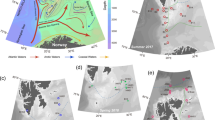Abstract
Oxygen-deficient basins are common features of the ocean1. Studies of the response of benthic communities to low-oxygen conditions have previously been restricted to sediment infauna, and have reported mass mortalities during sudden oxygen depletion2–4 and low species diversity during sustained oxygen deficiencies5,6. The deep epibenthic fauna of a 220-m deep fjord in British Columbia experiences annual conditions of low oxygen (<1.0 ml l−1). I have observed the reactions of the attached fauna to the changing oxygen levels during numerous dives in the submersible Pisces IV over 10 months, and report here that, despite records of the decimation of benthic invertebrate populations2–5,7–9, this deep-water assemblage maintains a higher diversity and animal abundance than does much of the upper photic zone. The tolerance developed by this community for a wide range of oxygen conditions, including periods of anoxia, has interesting implications for physiology, behaviour and community evolution.
Similar content being viewed by others
References
Richards, F. A. in Chemical Oceanography Vol. 1 (eds Riley, J. P. & Skirrow, G.) 611–645 (Academic, London, 1965).
Brongersma-Sanders, M. Mem. geol. Soc. Am. 67, 941–1008 (1957).
Levings, C. D. in Fjord Oceanography (eds Freeland, H. J. et al.) 515–522 (Plenum, New York, 1979).
Tulkki, P. Cah. Biol. mar. 6, 455–463 (1965).
Rosenberg, R. J. exp. mar. Biol. Ecol. 26, 107–133 (1977).
Rhoads, D. C. & Morse, J. W. Lethaea 4, 413–428 (1971).
Leppakoski, E. Cah. Biol. mar. 10, 163–172 (1969).
Kitching, J. A. et al. J. Anim. Ecol. 45, 731–758 (1976).
Rosenberg, R. in Fjord Oceanography (eds Freeland H. J. et al.) 499–514 (Plenum, New York, 1979).
Connell, J. H. Science 199, 1302–1310 (1978).
Anderson, J. J. & Devol, A. H. Estuar. coastal mar. Sci. 1, 1–10 (1973).
Gade, H. G. & Edwards, A. in Fjord Oceanography (eds Freeland, H. J. et al.) 453–490 (Plenum, New York, 1979).
Herlinveaux, R. H. J. Fish. Res. Bd Can. 19, 1–37 (1962).
Pac. mar. Rep. Ser. 80-5 (Inst. Ocean Sciences, Sidney, British Columbia, 1980).
Levin, S. & Paine, R. T. Proc. natn. Acad. Sci. U.S.A. 71, 2744–2747 (1974).
Berkner, L. V. & Marshall, L. C. J. atmos. Sci. 22, 225–261 (1965).
Herlinveaux, R. H. Fish Res. Bd Can. tech. Rep. 99, (1968).
Pielou, E. C. An Introduction to Mathematical Ecology (Wiley, New York, 1969).
Author information
Authors and Affiliations
Rights and permissions
About this article
Cite this article
Tunnicliffe, V. High species diversity and abundance of the epibenthic community in an oxygen-deficient basin. Nature 294, 354–356 (1981). https://doi.org/10.1038/294354a0
Received:
Accepted:
Issue Date:
DOI: https://doi.org/10.1038/294354a0
- Springer Nature Limited
This article is cited by
-
An 8-year record of phytoplankton productivity and nutrient distributions from surface waters of Saanich Inlet
Scientific Data (2022)
-
Oxygen production from macrophytes decreases development time in benthic egg masses of a marine gastropod
Hydrobiologia (2015)
-
Ecosystem studies on upper region of Ganga River, India
Environmental Monitoring and Assessment (1995)
-
A-nor-steranes, a novel class of sedimentary hydrocarbons
Nature (1982)





